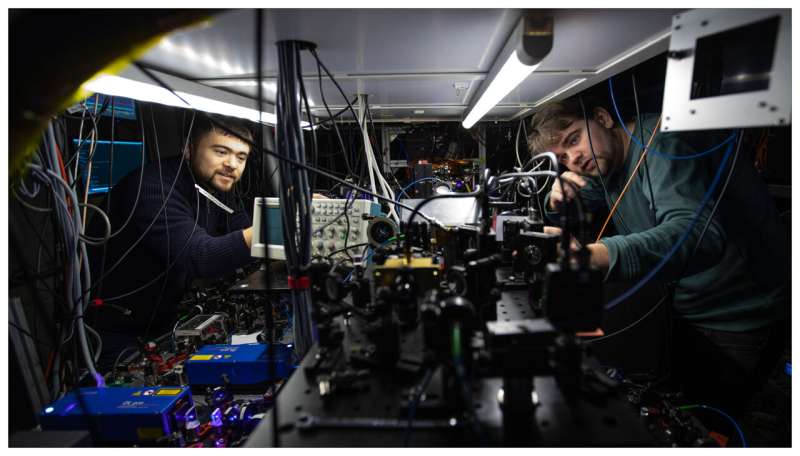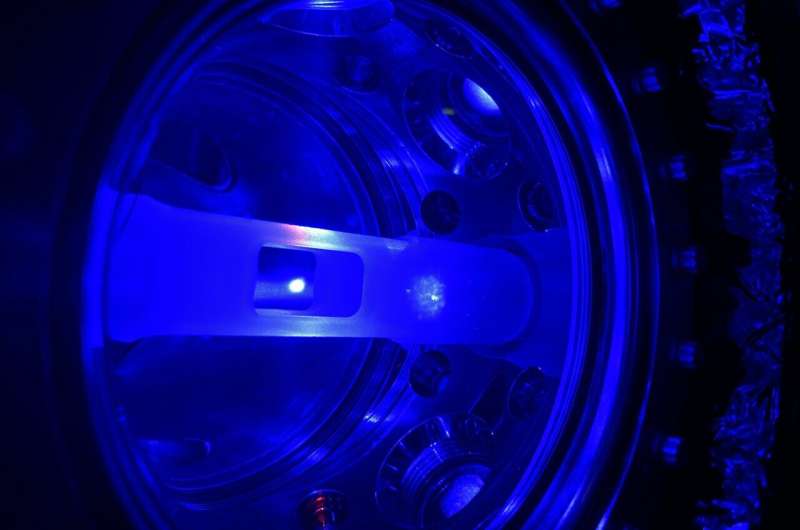The glowing ball in the middle, called a “magneto-optical trap” (MOT), consists of about 300 million strontium atoms suspended in a vacuum chamber cooled to just above absolute zero. Researchers have exploited this trap to develop new techniques for measuring time.Image credit: Eliot Bohr
Superradiant atoms could help us measure time more precisely than ever before. In a recent study, researchers at the University of Copenhagen have proposed a new method of measuring time intervals (seconds) that alleviates some of the limitations encountered by today’s most advanced atomic clocks. The results could have broad implications for areas such as space travel, volcanic eruptions and GPS systems.
The second is the most precisely defined unit of measurement compared to other basic units such as the kilogram, meter and degree Kelvin. Currently, time is measured using atomic clocks in different places around the world, which together tell us what time it is. Atomic clocks use radio waves to continuously send signals to synchronize our computers, phones and watches.
Oscillation is the key to keeping time. In a grandfather clock, these oscillations come from the pendulum swinging from side to side every second, while in an atomic clock it’s a laser beam that corresponds to the energy transition of strontium, which oscillates about a quadrillion times per second.
But according to Dr. Even atomic clocks could become more accurate, according to Eliot Bohr (great-grandson of Niels Bohr), a researcher at the Niels Bohr Institute. That’s because the detection lasers used by most modern atomic clocks to read the atoms’ oscillations heat the atoms so much that they escape, reducing accuracy.
“Because atoms constantly need to be replaced by new atoms, and while preparing new atoms, the clock loses very little time. So we are trying to overcome some of the challenges and limitations of the best atomic clocks in the world today by: Among other things, Bohr explains, the atoms are reused so they don’t need to be replaced as often.
He is the lead author of a new study published in the journal nature communicationswhich uses an innovative and potentially more efficient method of measuring time.
Superradiation and cooling to absolute zero
The current method involves a hot furnace that sprays about 300 million strontium atoms into a very cold ball of cold atoms, called a magneto-optical trap (MOT). The atoms have a temperature of about -273°C, very close to absolute zero, and have two mirrors with a light field between them to enhance atomic interactions. Together with his research colleagues, Bohr developed a new method of reading atoms.
“When atoms landed in a vacuum chamber, they were completely stationary because the chamber was very cold, which made it possible to record their oscillations with two mirrors at either end of the chamber,” Bohr explained.
The reason researchers don’t need to use lasers to heat atoms and destroy them is because of a quantum physics phenomenon called “superradiation.” This phenomenon occurs when clusters of strontium atoms become entangled and simultaneously emit light in a field between two mirrors.
“Mirrors make the atoms behave as a unit. Together they emit a powerful light signal that we can use to read out the atomic state, which is a key step in measuring time. This method minimizes the heating of the atoms, so it all works It can happen without replacing atoms, potentially making it a more precise method of measurement,” Bohr explained.

Eliot Bohr (left) and colleague Thorfers Laguna Christensen begin experiments at the Niels Bohr Institute. Photo: Ola J. Joensen, NBI. Image Credits: Photo: Ola J. Joensen, NBI.
GPS, space missions and volcanic eruptions
Bohr said the new research results may help develop more accurate GPS systems. In fact, around 30 satellites constantly orbit the Earth and tell us where we are, and they require atomic clocks to measure time.
“Every time a satellite determines the location of your phone or GPS, you are using the atomic clock in the satellite. The accuracy of the atomic clock is very important. If the atomic clock is off by one microsecond, it means an error of about 100 meters on the Earth’s surface.” Bohr explained.
Future space missions are another area where researchers expect more accurate atomic clocks to have a major impact.
“When people and spacecraft are launched into space, they venture far away from our satellites. Therefore, the requirements for precise time measurement for space navigation are much higher,” he said.
The results may also help develop a new generation of smaller, portable atomic clocks that can be used for more than “just” measuring time.
“Atomic clocks are sensitive to changes in gravity and therefore can be used to detect changes in the Earth’s mass and gravity, which can help us predict when volcanic eruptions and earthquakes will occur,” Bohr said.
Bohr stressed that while the new method of using superradiant atoms was very promising, it was still a “proof of concept” that needed further refinement.
The research was conducted by the team of Jörg Helge Müller and Jan Thomsen at the Niels Bohr Institute in collaboration with Ph.D. students Sofus Laguna Kristensen and Julian Robinson-Tait, and postdoc Stefan Alaric Schäffer. The project also includes contributions from theorists Helmut Ritsch and Christoph Hotter of the University of Innsbruck and Tanya Zelevinsky of Columbia University. This work highlights the importance of international cooperation in science.
More information:
Eliot A. Bohr et al., Collectively enhanced Ramsey readings through the cavity subradiant to superradiant transition, nature communications (2024). DOI: 10.1038/s41467-024-45420-x
Provided by the University of Copenhagen
citation: Superradiant atoms could push boundaries on time measurement accuracy (2024, April 22), Retrieved April 22, 2024, from https://phys.org/news/2024-04-superradiant-atoms-boundaries- precisely.html
This document is protected by copyright. No part may be reproduced without written permission except in the interests of fair dealing for private study or research purposes. Content is for reference only.
#Superradiant #atoms #push #boundaries #time #measurement #accuracy
Image Source : phys.org
